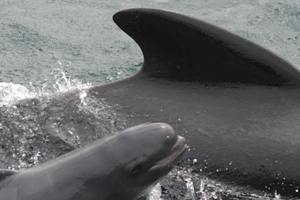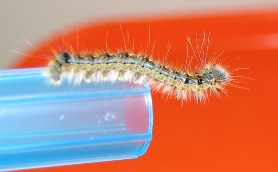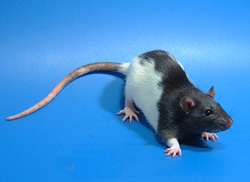
.
 |
I have recently finished my M.Sc. research at Dalhousie University (Halifax), studying long-finned pilot whales with Hal Whitehead. My thesis can be found here. This site will no longer be updated, but feel free to contact me at lnemiroff (at) dal.ca. |
Education:
2006 - 2009: Dalhousie University, MSc Biology
-
Supervisor: Dr. Hal Whitehead
-
Subject: Structural variation and communicative functions of long-finned pilot whale pulsed calls and complex whistles
-
Funded by a PGS-M NSERC (2006-08) and the Dr. Patrick Lett Fund (2009)
-
Vice-President, BOGS (Biology Organization of Graduate Students) 2007-2008
2002 - 2006: Concordia University, BSc Biology
-
Honours Biology, Minor Multidisciplinary Studies in Science
-
Member of Concordia's Science College
Publications and presentations:
Peer-reviewed publications:
Nemiroff, L., Wimmer, T., Daoust, P-Y., McAlpine, D. (in prep). Cetacean strandings in the Canadian Maritime provinces between 1990 and 2008.
Nemiroff, L. and Whitehead, H. (in press). Structural characteristics of pulsed calls of long-finned pilot whales, Globicephala melas. Bioacoustics.
Nemiroff, L. & Despland, E. (2007). Consistent individual differences in forest tent caterpillar (Malacosoma disstria) foraging behaviour. Canadian Journal of Zoology, 85(11): 1117-1124. (pdf)
Nemiroff, L. & Patterson, J. (2007). Design, testing and implementation of a large-scale urban dog waste composting program. Compost Science & Utilization, 15(4): 237-242. (pdf)
Venter, O., Brodeur, N. N., Nemiroff, L., Belland, B., Dolinsek, I. J., & Grant, J. W. A. (2006). Threats to Endangered Species in Canada. BioScience, 56(11): 903-910. (pdf)
MSc thesis:
Nemiroff, L. (2009). Structural variation and communicative functions of long-finned pilot whale (Globicephala melas) pulsed calls and complex whistles. Master's thesis, Biology Department, Dalhousie University, Halifax, Nova Scotia. (pdf)
Conference presentations:
Oral presentations: (* indicates presenter)
Nemiroff, L.* & Whitehead, H. (March 2009). Long-Finned Pilot Whale Pulsed Calls. Northeast Biological Graduate Student Conference (NBGSC), Halifax, Nova Scotia.
Nemiroff, L.* (2008). Eavesdropping on Potheads: the Ups and Downs of Studying Pilot Whale Vocalizations. Friday Informal Seminar Hour (FISH), Dalhousie University, Halifax, Nova Scotia.
Nemiroff, L.*, Venter, O., Brodeur, N. N., Belland, B., Dolinsek, I. J., & Grant, J. W. A. (2007). Threats to Endangered Species in Canada. Northeast Biological Graduate Student Conference (NBGSC). Halifax, Nova Scotia.
Nemiroff, L. & Patterson, J.* (2006). Large Scale Dog Manure Composting: A Potential Municipal Waste Management Strategy. Geological Association of Canada Conference (GAC). Montreal, Quebec.
Nemiroff, L.* & Despland, E. (2005). Behavioural Syndromes and Individual Behaviour of the Forest Tent Caterpillar, Malacosoma disstria. Societe Quebecoise pour l'etude biologique du comportement (SQEBC). Montreal, Quebec.
Posters: (* indicates presenter)
Nemiroff, L.* & Whitehead, H. (2008). Pulsed calls from long-finned pilot whales (Globicephala melas) off Cape Breton, Nova Scotia. European Cetacean Society Conference (ECS). Egmond aan Zee, the Netherlands.
Nemiroff, L.* & Whitehead, H. (2008). A description of pulsed calls from long-finned pilot whales (Globicephala melas) off Cape Breton, Nova Scotia. Northeast Biological Graduate Student Conference (NBGSC). Maine, USA.
Nemiroff, L. & Despland, E.* (2006). Individual Behaviour of the Forest Tent Caterpillar, Malacosoma disstria. Canadian Society for Ecology and Evolution Conference (CSEE). Montreal, Quebec.
Nemiroff, L.* & Despland, E. (2005). Individual Behaviour of the Forest Tent Caterpillar, Malacosoma disstria. Conference societe d'entomologie du Quebec, Mille et une entomologies (SEQ). Montreal, Quebec.
Nemiroff, L.* & Patterson, J. (2005). Dog Waste Composting: Design, Testing and Implementation. Concordia University Science Conference. Montreal, Quebec.
Nemiroff, L.* & Despland, E. (2005). Individual Behaviour of the Forest Tent Caterpillar, Malacosoma disstria. Concordia University Science Conference. Montreal, Quebec.
Guest Lectures:
Long-finned pilot whales (Globicephala melas). Marine Mammology course, Dalhousie University, Feb. 2009
Studying long-finned pilot whales (Globicephala melas): background information and field techniques. Marine Mammal Field Course, Dalhousie University, Aug. 2008
Research:
2006 - 2009: Long-finned pilot whale pulsed calls and whistles

Long-finned pilot whales (Globicephala melas) are an extremely vocal species, producing clicks, whistles and pulsed calls during a variety of contexts. For mobile marine mammals, the acoustic channel is often the primary method of communication between individuals, and pilot whale vocalizations likely play an important role in both social and behavioural interactions. I examined the pulsed calls and complex whistles of a population of pilot whales off the northwest coast of Cape Breton, Nova Scotia using recordings made during 4 field seasons spanning 8 years. Pilot whale pulsed calls were found to be physically complex, with multiple components that are likely rich in information and difficult for eavesdroppers to imitate. The structure of pilot whale pulsed calls was highly similar to those of killer whales (Orcinus orca), which raises the question of whether the distantly related species, sharing a common rare social structure, evolved similar call structures to solve similar communication problems.
Both the pilot whale pulsed calls and whistles appear to be non-discrete. Statistical measures of similarity from measurements of call spectrograms and perceptual measures of similarity from human observers were used to produce similarity matrices for pulsed calls and complex whistles. Naïve and experienced human participants were highly consistent with each other when rating both sound classes, although the statistical and perceptual methods were only moderately correlated. Each method of rating call similarity had important advantages, and thus both were used to examine the similarity of complex whistles and pulsed calls across social, behavioural and group composition contexts.
Pulsed calls vary strongly between social units or groups producing the calls, as well as among the behavioural or arousal states of the whales. The similarity of aspects of pulsed call structure within clusters of social units suggests the possibility of broader vocal clans. The structure of complex whistles, which are produced mainly during active behaviours, is instead most strongly influenced by the average number of whales present. Pulsed calls may function in unit membership identification, group cohesion and the transmission of information during social interactions. Complex whistles may serve a more population-wide function, facilitating group coordination during active behaviour and over large distances.
Supervised by: Dr. Hal Whitehead, Biology, Dalhousie University
2005 - 2006: Threats to endangered species in Canada

We quantified the threats facing 488 species in Canada, categorized by COSEWIC (Committee on the Status of Endangered Wildlife in Canada) as extinct, extirpated, endangered, threatened, and special concern. Habitat loss is the most prevalent threat (84%), followed by overexploitation (32%), native species interactions (31%), natural causes (27%), pollution (26%), and introduced species (22%). Agriculture (46%) and urbanization (44%) are the most common human activities causing habitat loss and pollution. For extant species, the number of threats per species increases with level of endangerment. The prevalence of threat types varies among major habitats, with overexploitation and introduced species being particularly important and unimportant, respectively, for marine species. Compared to the United States, introduced species are much less important in Canada, but the causes of endangerment are broadly similar for Canadian and globally endangered species.
Supervised by: Dr. James Grant, Biology, Concordia University
2004 - 2005: Individual behaviour of the forest tent caterpillar, Malacosoma disstria

Differences in individual behaviour may be an important factor in the outbreak cycles of some insects, and behavioural polyphenisms have been suggested to play a role in the population dynamics of Malacosoma spp. (Lepidoptera: Lasiocampidae). A novel technique was developed to determine if individual M. disstria larvae exhibit distinct and persistent behavioural tendencies. Second instar caterpillars were placed on individual arenas for one hour on four consecutive days, and the proportion of time spent walking, searching, quiescent, and eating was documented. Stable individual activity trends were observed. Active and sluggish behavioural types were distinguished.
The limited plasticity observed may generate tradeoffs that limit the ability of the species to survive limiting environmental variables, and behavioural correlations across contexts may eventually link birth, death and dispersal processes in unprecedented ways (Sih et al., 2004). Multi-faceted research regarding the extent to which variation penetrates larval colonies of outbreaking insects, such as M. disstria, clearly plays a vital role in behavioural ecology and pest management.
Supervised by: Dr. Emma Despland, Biology, Concordia University
2004 - 2005: Composting Dog Waste: The design, testing and implementation of a large scale dog waste composting program

Waste management is a significant issue for large municipalities. Urban garbage is typically sent to large landfill sites. However, a large problem with this is the lack of new space and community objections to the siting of new large conventional landfills. Composting of organic waste is one solution for reducing the volume of material being sent to landfills. In Montreal, dog owners often use fenced-in dog parks and manure is typically collected by the owner in a plastic bag and disposed of in the municipal garbage, destined for the landfill site. Consequently, these high-density dog parks are the source of a large amount of dog waste requiring disposal. Aerobic composting is one method for eliminating dog waste while producing a beneficial soil amendment product.
In 2004, an experimental large scale dog waste composting programme was initiated at the Notre-Dame-de-Grâce (NDG) dog run in Montreal, Québec. In two months, the two research compost bins collected a total of 470 pounds of dog waste and 72 pounds of sawdust. After a year of incubation, the research bins produced 394 pounds of a useable soil amendment product characterized by an average 46% decrease in mass. Temperatures in the research bins peaked between 40°C and 55°C but were not maintained long enough for conclusive elimination of pathogens. Participation by dog run users during the trial project was high, and full-scale dog waste composting has now been implemented at the dog run, with nine bins being filled over a 12 month period. On an annual basis, this composting programme diverts over a ton of dog waste (approximately 2115 pounds), over 300 pounds of sawdust, and nearly 3000 plastic bags from Montreal's landfill site. It is producing nearly 1700 pounds of compost annually.
Supervised by: Dr. Judith Patterson, Environmental Geoscience, Concordia University
2003 - 2004: Does alcohol cause sexual disinhibition in female Long-Evans rats?

This project was performed as a small part of a larger investigation using Long-Evans rats as human models to determine the effect of alcohol, drugs and other chemicals on female sexuality. After performing ovariectomies on a group of female Long-Evans rats, 80 were selected and used for this trial. I injected the females subcutaneously with estrogen and progesterone prior to testing, and then injected them interperitoneally with varying doses of ethanol and saline solution 30 minutes before trials began. The females were then individually placed in split-level cages with a male Long-Evans rat and videotaped for one hour. This was a preliminary test, and further studies are currently being performed by the Pfaus lab.
Supervised by: Dr. James Pfaus, Psychology, Concordia University
Links: